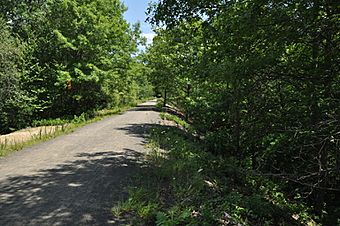Rapallo Viaduct facts for kids
Quick facts for kids |
|
|
Rapallo Viaduct
|
|

View of the top of the filled-in viaduct
|
|
| Location | Flat Brook and former Air Line Railroad right-of-way, East Hampton, Connecticut |
|---|---|
| Area | 1 acre (0.40 ha) |
| Built | 1873 |
| Architect | Edward W. Serrell; Phoenix Iron Works |
| NRHP reference No. | 86002728 |
| Added to NRHP | August 21, 1986 |
The Rapallo Viaduct is a special bridge hidden underground in East Hampton, Connecticut. It helps the Air Line Trail cross over a stream called Flat Brook. This old railroad bridge is unique because it was built from iron and later completely buried.
Contents
Building the Rapallo Viaduct
The Rapallo Viaduct was built for a railroad line connecting New Haven to Willimantic. This railway was part of a direct route between Boston and New York City. To make the route straight, the railroad had to cross deep valleys.
One of these valleys was Flat Brook, near East Hampton. A tall bridge was needed here. The bridge was named after Charles A. Rapallo, who was one of the railroad's leaders.
Designing an Iron Bridge
Around 1870, building bridges entirely from wrought iron was a very new idea. Edward W. Serrell, the main engineer for the railroad, designed this tall iron bridge. Even though he was a skilled bridge builder, he needed help with some parts of the design.
So, the job of designing the bridge's parts went to the Phoenix Iron Works. This company also built the bridge. The bridge was first meant to have two tracks for trains. But Serrell worried it might not be strong enough. He decided to make it a single track bridge before it was finished.
Concerns About Safety
The bridge was completed in 1873. Serrell was no longer the chief engineer by then. He wrote to the railroad officials in Connecticut. He was worried about how the iron bridges on the line, including the Rapallo Viaduct, were designed and built.
The officials asked James Laurie, a famous civil engineer, to check the bridges. Laurie inspected them and said they were safe to use.
Why the Bridge Was Buried
The railroad line was finished in 1873. However, a big money crisis called the Panic of 1873 happened. The railroad also spent a lot of money building the line. Because of this, the company went bankrupt. It was reorganized as the Boston and New York Air-Line Railroad in 1875.
A few years later, in 1879, the New York, New Haven and Hartford Railroad took over the line. They operated the Rapallo Viaduct. By the early 1900s, the iron bridge was not strong enough for the New Haven's heavier freight trains.
Filling in the Viaduct
In 1911, the New Haven railroad proposed a plan to the state officials. They wanted to put Flat Brook into a pipe (a culvert) and then fill in the entire viaduct with dirt. The plan was approved.
From 1912 to 1913, workers dumped sand from the train tracks onto the bridge. They kept dumping sand until the viaduct was completely covered. They then put a layer of cinders on top. This process hid the bridge and helped to keep it safe.
The Viaduct Today
Passenger trains stopped using the filled-in viaduct by 1937. The train tracks were completely removed in 1965. In 1986, the viaduct was added to the National Register of Historic Places. This was also when the old railroad line became a walking and biking path called a rail trail.
The Rapallo Viaduct is still covered by the fill today. In 1979, a sewer line was buried in the fill. This showed that the bridge underneath was mostly still in good shape. In 2007, part of the culvert collapsed, but it was fixed that same year.
Because it was buried, the Rapallo Viaduct was protected. Other iron bridges from that time were torn down. The Rapallo Viaduct and the Lyman Viaduct are the only bridges left in Connecticut from the very first time iron bridges were built.



